Montanha Wudang, Shiyan - Bilhetes, horário de abertura, localização e destaques
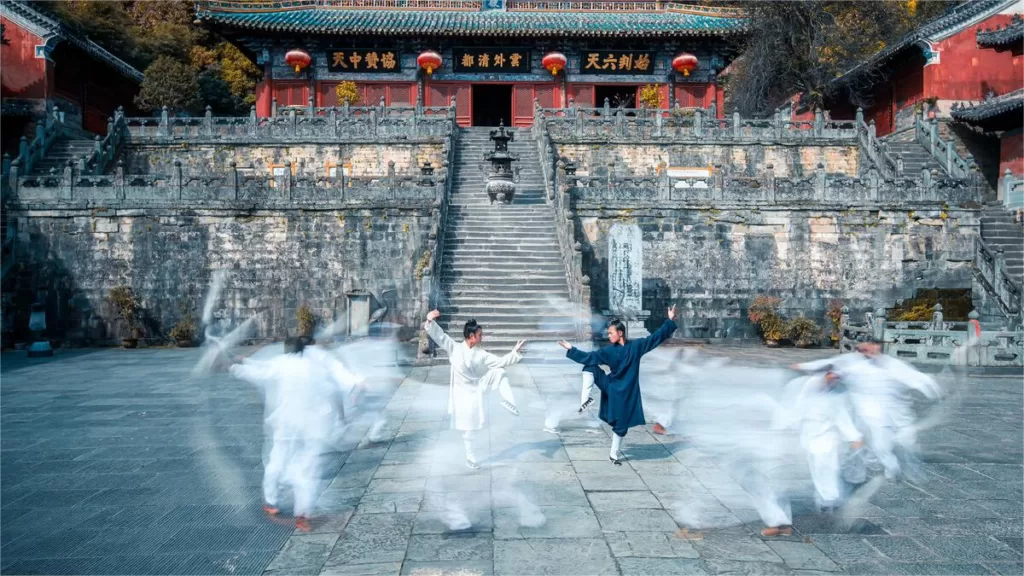

Wudang Mountain (武当山, Mount Wudang), located in Shiyan City in the northwest of Província de Hubei, is renowned as a sacred site in Chinese Taoism, earning the title “Peerless Wonderland, Number One Fairy Mountain Under Heaven.” Emperor Yongle’s project to “build the Forbidden City in the north and renovate Wudang in the south” established Wudang Mountain’s Taoist temples as ancestral temples of the Ming Dynasty’s imperial family, setting its status above the original five sacred mountains. This initiative endowed the ancient structures here with grandeur reminiscent of imperial palaces. Designed according to the myth of the Zhenwu Emperor’s cultivation, the layout adds an element of mystical wonder to the Taoist heritage.
Wudang Mountain boasts the world’s largest religious architectural complex, spanning 70 kilometers, and Asia’s largest artificial lake – Tai Chi Lake, a source of water for the South-North Water Diversion Project. The region is also home to the awe-inspiring natural spectacle of 72 peaks facing the main summit and the profoundly sacred cultural wonder of the “Divinely-Created Xuanwu.” Collectively, Wudang Mountain stands as one of the most beautiful places in the world, blending religious significance, natural splendor, and cultural marvels.
Índice
- Informações básicas
- Localização e transporte
- Highlights of Wudang Mountain
- Vlog about Wudang Mountain
- Dicas úteis resumidas a partir de comentários
- Outras atracções em Danjiangkou
Informações básicas
| Duração estimada da excursão | 1 - 2 dias |
| Preço do bilhete | 264 RMB |
| Teleférico | One-way Upward: 80 RMB Round: 150 RMB |
| Horário de funcionamento | 7.30 - 17.00 |
| Número de telefone | 0086-0719-5665396 |
Localização e transporte
Wudang Mountain is situated in the northwest part of Hubei Province, near the city of Shiyan and Danjiangkou City. It borders Xiangyang City to the east, is adjacent to Shiyan City in the west, faces Shennongjia to the south, and overlooks the Danjiangkou Reservoir, the source of the South-North Water Diversion Project, to the north. There are several transportation options to reach Wudang Mountain:
- Wudangshan Airport: Located approximately 30 kilometers from the scenic area’s main entrance, the airport offers an airport shuttle bus to Wudang Mountain (approximately 15 yuan per person), with a travel time of around 45 minutes.
- Shiyan Railway Station: About 38 kilometers from the main entrance, you can take Bus 202 to the final stop and walk approximately 200 meters to the scenic area (approximately 4 yuan per person). The entire journey takes about 90 minutes.
- Wudangshan Station (Railway Station): Situated about 18 kilometers from the main entrance, you can take Bus 202 (approximately 4 yuan per person) to the final stop and walk around 200 meters to the scenic area, with a travel time of approximately 20 minutes.
- Wudangshan West Station: The high-speed railway station is around 12 kilometers from the main entrance. You can take a direct bus to the scenic area (approximately 10 yuan per person), and the entire journey takes about 12 minutes.
Highlights of Wudang Mountain
Taihe Palace (太和宫)
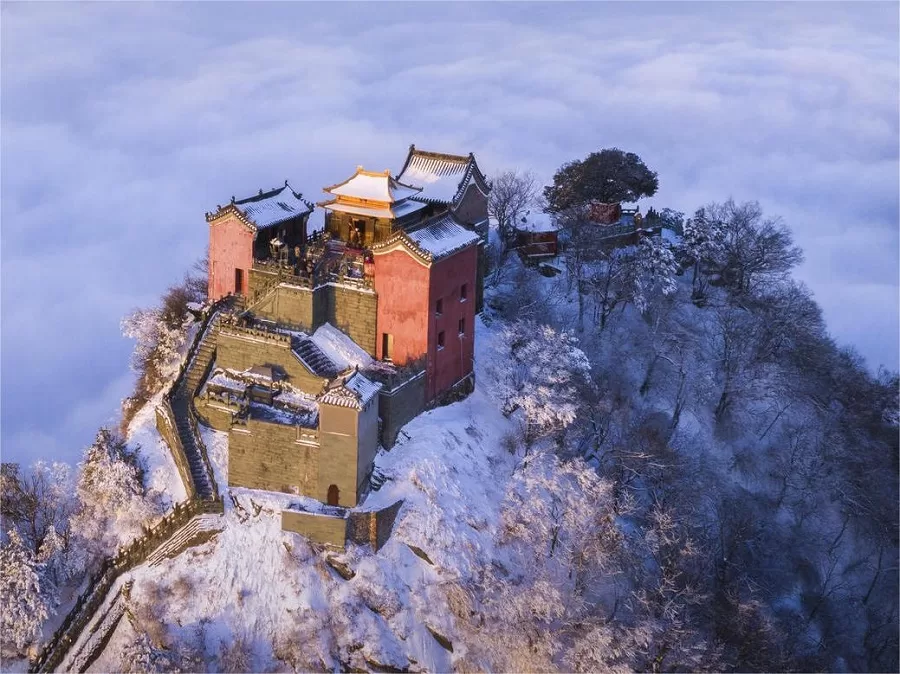
Nestled on the southern side of Tianzhu Peak, Taihe Palace covers an area of 80,000 square meters and features over 20 ancient buildings with a total construction area of over 1,600 square meters. Perched atop isolated peaks and ridges, the intricate structures, including halls and pavilions, make it the highest scenic spot on Wudang Mountain. Whether for Taoist priests or pilgrims, reaching the summit and entering Taihe Palace is considered the true arrival at Wudang Mountain. In the 10th year of the Ming Yongle era (1412), Emperor Yongle ordered the construction of Taihe Palace, and upon completion, he honored Wudang Mountain with the title “Grand Mountain of Taihe.” The Taoist temple built at the mountain’s summit was named “Grand Mountain Taihe Palace.”
Golden Palace (金殿)
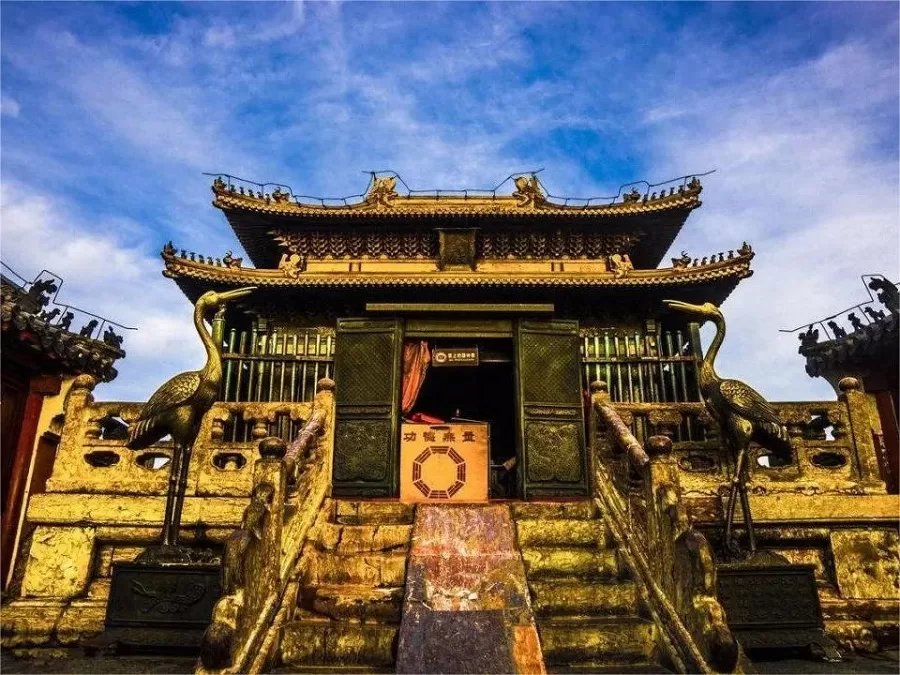
Positioned on Small Lotus Peak in front of Tianzhu Peak, the Golden Palace, cast in the 11th year of the Yuan dynasty (1307), stands at a height of 3 meters, with a width of 2.8 meters and a depth of 2.4 meters. Featuring a hanging-roof architectural style, the entire structure was cast in separate components, assembled with tenons and mortises. Each cast component bears inscriptions indicating its installation location. The skirt board is inscribed with “This palace was cast in the 11th year of the Yuan dynasty at Meiting Wan’s workshop in Wuchang.” It stands as one of the earliest surviving examples of bronze-cast wooden structures in China.
Zixiao Palace (紫霄宫)

Originally built during the Song dynasty in the Xuanhe period (1119–1125), Zixiao Palace underwent reconstruction in the Yuan dynasty and received the name “Zixiao Yuansheng Palace.” In the 10th year of the Ming Yongle era (1412), additional construction was undertaken and bestowed the name “Tai Xuan Zixiao Palace.” Expanded to 806 rooms in the 31st year of the Ming Jiajing era (1552), it has undergone several renovations since the establishment of the People’s Republic of China while preserving its original appearance. With 182 existing rooms and a construction area of 8,553 square meters, it covers an area of 74,000 square meters, designated as a key national cultural heritage site in 1982. Currently, it serves as the location for the Wudang Mountain Taoist Association.
Jingle Palace (静乐宫)

Ranking as the first of the eight palaces in Wudang Mountain, Jingle Palace was initially constructed in the 11th year of the Ming Yongle era (1413). Unfortunately, in 1958, during the construction of the Danjiangkou Reservoir, it was submerged. Subsequent efforts in 2002, with an investment of 70 million yuan from Danjiangkou City, successfully restored Jingle Palace. The first-phase construction included the square, mountain gate, imperial stele pavilion, three main halls, and ancillary halls, recapturing the grandeur of the original Jingle Palace.
Yuxu Palace (玉虚宫)
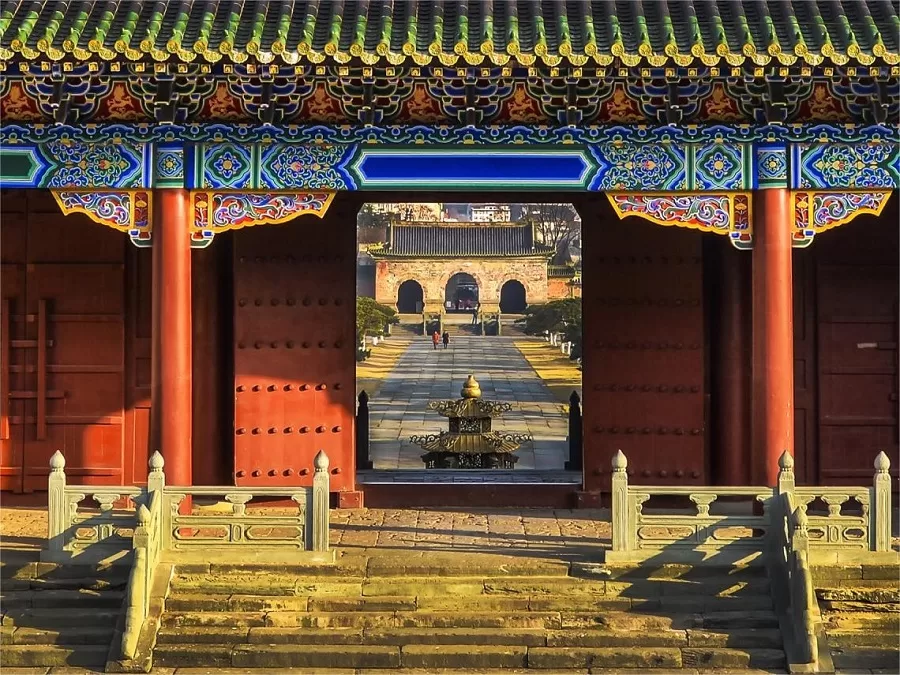
Also known as “Xuantian Yuxu Palace,” it was built in the 11th year of the Ming Yongle era (1413) with a total of 2,200 temples and halls. In the 31st year of the Ming Jiajing era (1552), it underwent renovation, becoming the largest single unit in the ancient architectural complex of Wudang Mountain. Unfortunately, most of it was destroyed in the 10th year of the Qing Qianlong era (1745). The remaining structures and relics include the restoration of the massive “Tortoise-Borne Stele” pavilion.
Needle Grinding Well (磨针井)
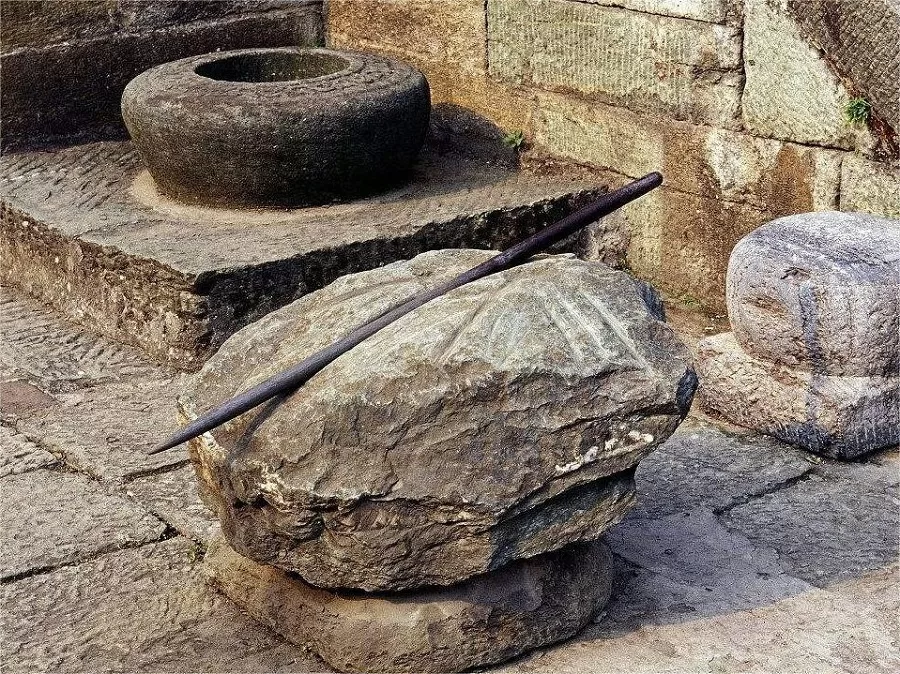
Located 12 kilometers south of Lao Ying, Needle Grinding Well was initially built during the Ming Yongle era. The existing well was reconstructed in the 2nd year of the Qing Xianfeng era (1852) and underwent restoration in 1984. It comprises more than 50 rooms covering an area of 1,700 square meters. Situated on elevated terrain, Wudang Taoism believes that, as the sun rises each day, Needle Grinding Well is the first to receive the pure Yang energy, earning it the title “Pure Yang Palace.”
Taizi Slope (太子坡)

Also known as Fuzhen Hall, Taizi Slope has retained its original scale, constituting a larger unit within Wudang’s architectural ensemble. Built in the 10th year of the Ming Yongle era (1412) and renovated in the 22nd year of the Qing Kangxi era (1683), it sits in front of Lion Peak, comprising 20 buildings with a total area of 3,505 square meters and covering an area of 60,000 square meters.
Nanyan (南岩)
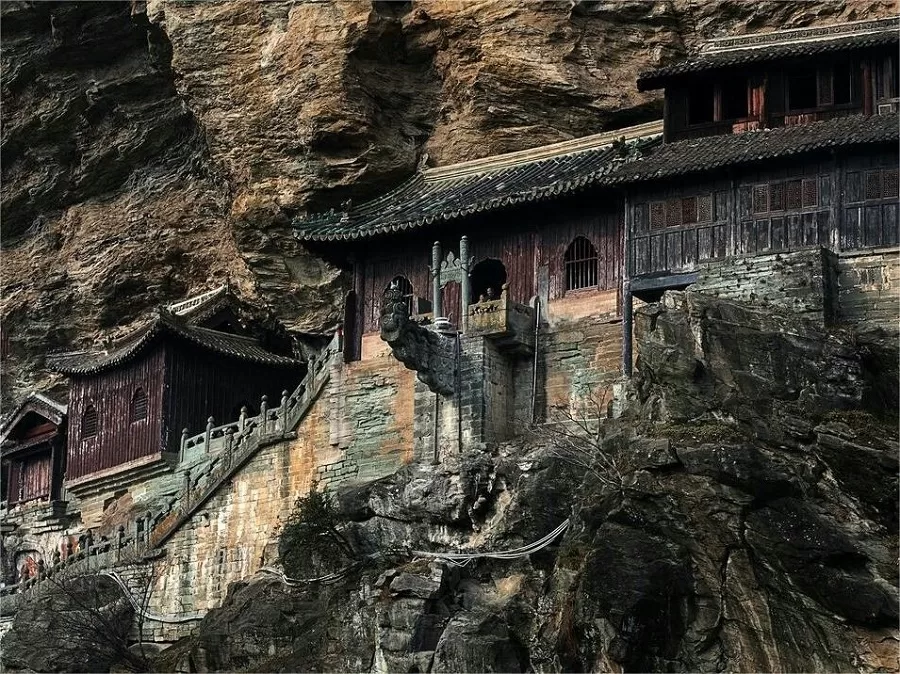
Referred to as the “Sacred Realm” where the Zhenwu Emperor achieved enlightenment and ascended, Nanyan is the most picturesque among the 36 peaks in Wudang Mountain. Nanyan Palace was initially built from the 22nd to the 25th year of the Yuan dynasty (1285–1310) and later expanded in the 10th year of the Ming Yongle era (1412). Nestled beneath Duyang Peak, it boasts a soaring mountainous landscape resembling the wings of a celestial being, celebrated for its magnificent peaks and ridges. Presently, it comprises 21 buildings spanning 90,000 square meters. Key structures include the Tianyi Zhenqing Palace Stone Hall, Liangyi Hall, Huangjing Hall, Bafeng Pavilion, Longhu Hall, Dabeiting Pavilion, and the South Heavenly Gate. The main structure, Tianyi Zhenqing Palace Stone Hall, predates the year 1310, featuring a width of 11 meters, depth of 6.6 meters, and height of 6.8 meters. The entire structure, including beams, pillars, doors, and windows, is intricately carved from blue stone. The roof has a single-eave resting-gable style in the front and a hanging mountain style in the back, following the architectural practices of Liao and Jin dynasties. The dragon head incense burner, measuring 3 meters in length and a mere 0.33 meters in width, stretches out into the open space, hanging over a deep valley, presenting a precarious and majestic appearance.
Qiongtai Temple (琼台观)

Located approximately 10 kilometers southeast of Tianzhu Peak, with a vertical distance of 1350 meters, Qiongtai Temple is divided into upper, middle, and lower sections. In the Yuan dynasty, it was known as “Qiongtai Palace.” During the Ming and Qing dynasties, it underwent renovation and expansion, featuring 24 Daoist courtyards and hundreds of temple rooms. Unfortunately, it was destroyed by warfare in the 6th year of the Qing Xianfeng era (1856). Some temple rooms have been restored. It serves as the starting point of the Wudang Mountain passenger cable car and has become a significant gathering point for tourists.
Daming Peak (大明峰)

Situated in Luomagou Village, Guanshan Town, Danjiangkou City, also known as Wuzhu Peak or Zhutou Rock, Daming Peak resembles the seated statue of Zhenwu (True Martial Emperor). During the Yuan dynasty, Wangmu Palace (Mother of Zhenwu) was constructed. Located 14 kilometers from Tianzhu Peak, it is one of the 72 peaks in Wudang, with an elevation of 1132 meters. The dual peaks resemble a pair of seats, and nestled between them is a natural stone statue approximately 80 meters tall and 40 meters wide, resembling the likeness of the True Martial Emperor atop the Golden Summit of Wudang Mountain.
Vlog about Wudang Mountain
Dicas úteis resumidas a partir de comentários
Ticket Validity and Additional Fees: The entrance ticket to Wudang Mountain is valid for three days. If you plan to visit again within this period, you only need to pay a 20 yuan fee for the shuttle bus.
Zixiao Palace Performance: Around 11 a.m., there is a performance at the Zixiao Palace. Make sure to check the schedule to catch this cultural experience and plan your visit accordingly.
Prepare for Cold Weather at the Summit: Evenings at the mountain summit can be significantly colder than at the base, with temperatures dropping by 9 to 10 degrees Celsius. Be sure to bring warm clothing to layer up and stay comfortable, especially if you plan to stay at the summit for an extended period.
Food Prices and Options: Meals on the mountain typically range from 30 to 50 yuan per dish. Prices are clearly marked, and there are cheaper options available, such as simple noodles priced around 10 to 20 yuan. Overall, the prices are comparable to those outside the scenic area.
Use of Trekking Poles: The ascent to the Golden Summit can be steep, especially for those not accustomed to hiking. Consider bringing a trekking pole for added stability and support, particularly if you’re not a frequent hiker.
Hydration and Snacks: There are shops along the way where you can purchase additional supplies if needed. Bringing along a bottle or two should suffice for the climb.
Plan for Visiting South Cliff Palace: Visiting the South Cliff Palace (南岩宫) requires a 2-hour hike (round trip), so be mindful of your energy levels and physical condition. Ensure you’re adequately prepared for the trek, including wearing appropriate footwear and carrying necessary supplies like water and snacks.
Outras atracções em Danjiangkou

Desfiladeiro de Tai Chi

Área cénica da barragem de Danjiangkou
Cenário de Hubei, Atracções de Shiyan